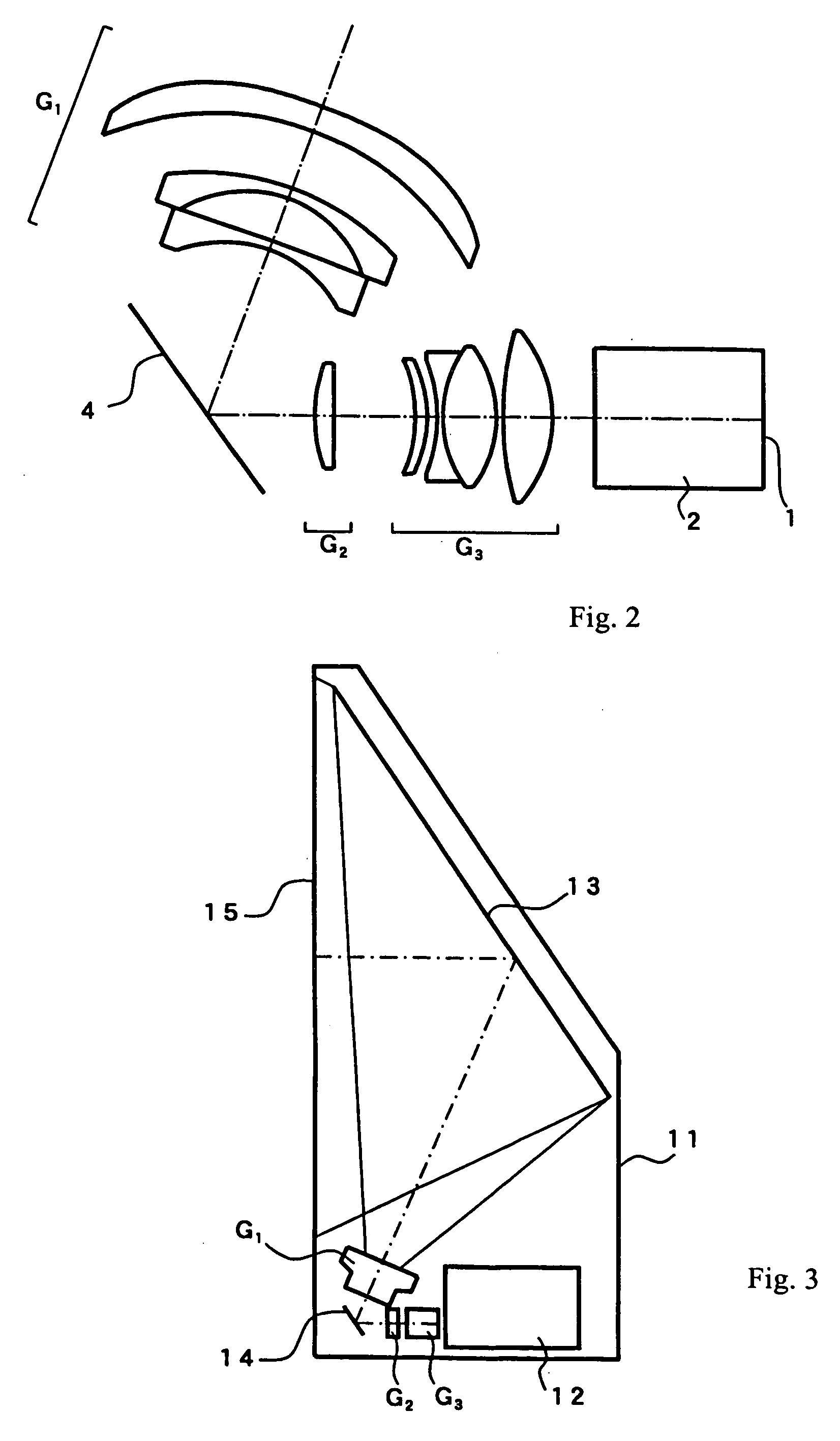Projection lens and projection display device using the same
a projection display device and projection lens technology, applied in the field of projection lenses, can solve the problems of difficult simultaneous satisfaction of all of the various demands described above, insufficient field angle and back focus, and difficult distortion correction, and achieve the effects of low cost, favorable correction of aberrations, and simple construction
- Summary
- Abstract
- Description
- Claims
- Application Information
AI Technical Summary
Benefits of technology
Problems solved by technology
Method used
Image
Examples
embodiment 1
[0069]FIG. 1 shows a cross-sectional view of the projection lens of Embodiment 1 of the present invention. As shown in FIG. 1, the projection lens of Embodiment 1 includes, arranged in order from the magnification side, a first lens group G1 that includes a first lens element L1 having negative refractive power, a meniscus shape, a convex surface on the magnification side, and two aspheric surfaces, a second lens element L2 having negative refractive power, a meniscus shape, and a concave surface on the reduction side, and a third lens element L3 having a biconcave shape and with its surface having the greater absolute value of refractive power on the reduction side.
[0070]The second lens group G2 includes a fourth lens element L4 having positive refractive power, a meniscus shape, and a convex surface on the magnification side.
[0071]The third lens group G3 includes a fifth lens element L5 of positive refractive power and meniscus shape with its convex surface on the reduction side a...
embodiment 2
[0082]FIG. 4 shows a cross-sectional view of the projection lens of Embodiment 2 of the present invention. The construction of this projection lens is roughly the same as the projection lens of Embodiment 1, but the construction of the third lens group G3 is different.
[0083]The third lens group G3 of the projection lens of Embodiment 2 includes, arranged in order from the magnification side: a fifth lens element L5 of positive refractive power and meniscus shape with its convex surface on the reduction side and both surfaces aspheric; a lens component formed by cementing together a sixth lens element L6 of biconvex shape having surfaces of different curvature with its surface of greater absolute value of refractive power being on the reduction side and a seventh lens element L7 of biconcave shape having surfaces of different curvature with the surface of greater absolute value of refractive power being on the magnification side; an eighth lens element L8 of biconvex shape having sur...
embodiment 3
[0096]FIG. 5 shows a cross-sectional view of the projection lens of Embodiment 3 of the present invention. The construction of this projection lens is roughly the same as the projection lens of Embodiment 1 but is different in that the position of the aperture stop is not shown. This projection lens has a space sufficient for a mirror for deflecting the optical path between the first lens group G1 and the second lens group G2 in a manner similar to that shown in FIG. 2 with regard to the mirror 4. This projection lens is constructed so as to be telecentric on the reduction side; therefore it is also suitable for a construction with glass block 2 operating as a color synthesizer.
[0097]Table 7 below lists the surface number # in order from the magnification side, the radius of curvature R of each surface on the optical axis, the on-axis surface spacing D, as well as the refractive index Nd and the Abbe number νd (both at the d-line of 587.6 nm) of each optical element for Embodiment 3...
PUM
 Login to View More
Login to View More Abstract
Description
Claims
Application Information
 Login to View More
Login to View More - R&D
- Intellectual Property
- Life Sciences
- Materials
- Tech Scout
- Unparalleled Data Quality
- Higher Quality Content
- 60% Fewer Hallucinations
Browse by: Latest US Patents, China's latest patents, Technical Efficacy Thesaurus, Application Domain, Technology Topic, Popular Technical Reports.
© 2025 PatSnap. All rights reserved.Legal|Privacy policy|Modern Slavery Act Transparency Statement|Sitemap|About US| Contact US: help@patsnap.com



